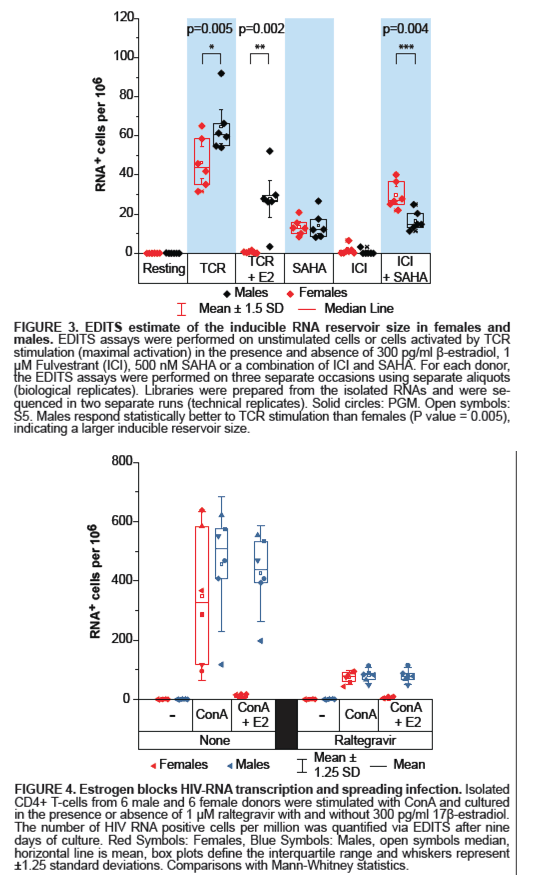 |
 |
 |
| |
Hormonal control of HIV-1 latency by estrogen imparts
gender-specific restrictions on the latent reservoir
|
| |
| |
IAS 2019
Reported by Jules Levin
Curtis Dobrowolski1, Saba Valadkhan1, Monica Gandhi2, Steven G. Deeks2, Eileen Scully3, Kathleen M. Weber4, Alan L. Landay5, & Jonathan Karn1
1 Department of Molecular Biology and Microbiology, Case Western Reserve University School of Medicine. Cleveland, OH, USA2 University of California San Francisco, Division of HIV, Infectious Diseases and Global Medicine, Department of Medicine, San Francisco, CA, USA3 Johns Hopkins University, Department of Medicine, Division of Infectious Diseases, Baltimore, MD, USA4 WIHS/CORE Center of Cook County Health, Chicago, IL, USA 5 Rush University Medical Center, Department Internal Medicine, Chicago, IL, USA
program abstract
Background: Unbiased shRNA library screens revealed that the estrogen receptor-α (ESR-1) is a key factor regulating HIV-1 latency. HIV emergence from the latent reservoir can be manipulated with native ligands, agonists, and antagonists to ESR-1.
Methods: Hormone receptor manipulation by shRNA, CRISPR-mediate gene editing and inhibitory compounds was studied in primary cell models (QUECEL, Th17) infected ex vivo. Leukapheresis samples from a cohort of 12 well-matched reproductive age women and men on fully suppressive ART were evaluated by a novel assay measuring production of spliced envelope (env) mRNA (the EDITS assay). Additionally, longitudinal samples from women progressing through menopause have been evaluated.
Results: Although both sexes responded to β-estradiol and selective estrogen receptor modulators (SERMs), females showed much higher levels of inhibition in response to the hormone and higher reactivity in response to SERMs than males. Importantly, the total inducible RNA reservoir, as measured by EDITS, was significantly smaller in the women than in the men. Remarkably, estrogen nearly completely blocked viral spread in females before and after menopause, but not in males. Agonists and antagonists to other hormone receptors, including thyroid receptors (TR), androgen receptor (AR), and the glucocorticoid receptor (GR), can modulate HIV expression but are much less potent than drugs targeting ESR-1.
Conclusions: We conclude that concurrent exposure to estrogen is likely to limit the efficacy of viral emergence from latency and that ESR-1 is a pharmacologically attractive target that can be exploited in the design of therapeutic strategies for latency reversal. A preliminary trial of the effects of Tamoxifen and vorinostat on the HIV reservoir among postmenopausal HIV-infected women has completed enrollment (ACTG A5366, ClinicalTrials.gov Identifier: NCT03382834). Our studies also suggest that high dose estrogen contraception might have an impact on HIV acquisition and suppression of the viral reservoir and that estrogen treatment in transgender people might reduce viral reservoirs.




|
| |
|
 |
 |
|
|